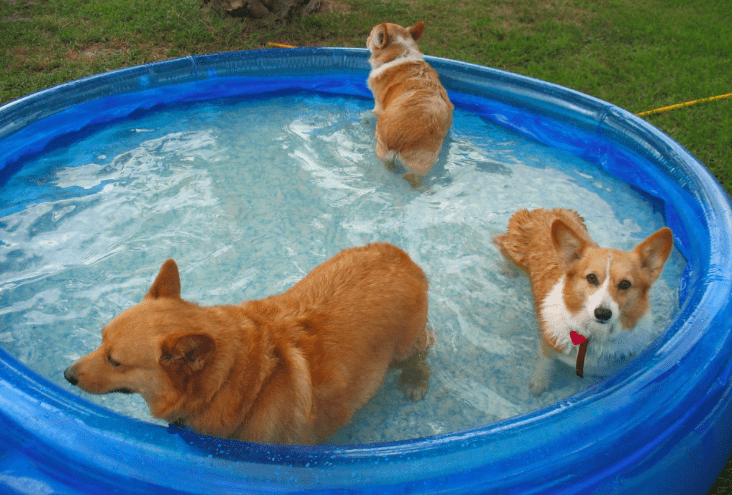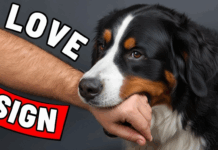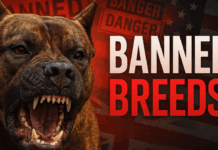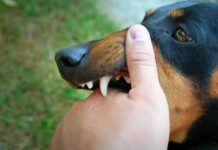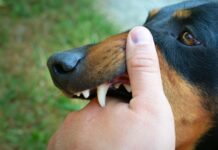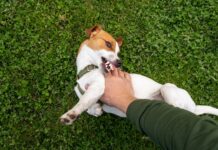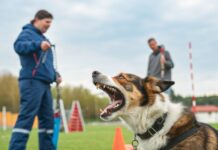Last Updated on May 11, 2021 by Dogs Vets
Can Pembroke Welsh Corgis Swim?
Can Pembroke Welsh Corgis be a unique dog known for its strange body shape? With an elongated body and short, squat legs, you may wonder if they can swim at all. So can Corgis actually swim?
Corgis can swim and enjoy swimming, although they are not water dogs by any stretch. Despite their short legs, they have potent thighs that help them move through the water. In fact, our Corgi family (Pippa) excels at swimming.
Almost any dog can swim naturally – some find it more difficult than others. Well, discuss why corgis are capable swimmers and what steps you should take to help your dog get into the water.
About Pembroke Welsh Corgi
The Pembroke Welsh corgi is a really small to medium-sized herding dog with short stature and a strong build. Known for its low-set body, large standing ears, and short tail, the Pembroke is also a great companion. The Pembroke Welsh Corgis breed is highly intelligent, loyal, and very active.
This Corgi breed and the Cardigan Welsh corgi are often confused, even though they are two separate breeds. Pembrokes have a slightly smaller build than cardigans, their ears are more pointed, and they have short, thick tails (as opposed to the long tail of the cardigan).

Pembroke Welsh Corgis Breed Overview
GROUP: Herding
HEIGHT: 10 to 12 inches
WEIGHT: 24 to 30 pounds
COAT AND COLOR: Medium length double coat in black and tan, red, sable, or fawn (all colors are typically seen with white markings)
LIFE EXPECTANCY: 12 to 13 years
History of the Welsh Corgi Pembroke
Many theories about the origin of the Pembroke Welsh corgi vary among a lot of experts, but it is commonly believed that the breed dates back to around the 10th century. One theory is that the ancestors of the breed were brought to Wales by Flemish weavers. Another theory suggests that they may have descended from the Swedish Vallhund. Either way, they have been a part of life in Wales for over 1,000 years.
The Pembroke Welsh Corgis are achondroplastic, a dwarf dog breed with shortened legs. They are known to be the shortest breed of the herding dog group. A very fanciful tale and fairy saddle marks seen on their backs are caused by fairies riding them.
Pembrokes were developed in Wales, England, where they were used as herding, companion, and/or guard dogs. There are obvious similarities between the Pembroke and Cardigan Welsh corgis, and these breeds have been crossed in the past. In 1934, both were officially recognized by the English Kennel Club and the American Kennel Club (AKC) as separate breeds.
You may be familiar with the pet corgi kept by Queen Elizabeth II. She has owned a Pembroke Welsh corgi since her father gave her one in 1933. They hold a special place in Buckingham Palace.
Some Pembrokes are born with only a tail. Traditionally, Welsh Pembroke corgi had their nails clipped, as this would indicate that the dog was a working dog and was exempt as a house dog.
Docking is not required for show dogs in the UK, but the AKC standard says that tails should not be docked more than 2 inches. Docking is illegal in many countries.
Pembroke Welsh Corgi Care
The Pembroke Welsh corgi has a medium-length topcoat with a short undercoat. The breed manages to shed a significant amount of fur, both every day and seasonally in the spring and fall.
Routine grooming of the Pembroke Welsh Corgis is essential. It consists mainly of brushing the hair once or twice a week, or even daily during shedding periods. Bathing can help control shedding. The good news about the Pembroke Welsh Corgis is that their coat is weather resistant.
Remember to trim your dog’s nails regularly to prevent tears and foot problems. You should also help your dog keep his teeth and gums healthy by brushing his teeth daily or at least a few times a week.
Intelligent and hardworking, the Pembroke excels at herding and most dog sports. This breed requires regular exercise. Because Pembroke craves activities and challenges, training is an absolute must. Start with the basics and then consider training your dog for a job, such as a guard dog or shepherd. Too much-unused energy and lack of training can lead to excessive barking and other behavior problems.
Early socialization is good for corgis because they tend to be naturally reserved with strangers. This trait makes them good watchdogs, but excessive fearfulness should be avoided.
Pembrokes usually do well with other dogs and cats that are part of their household, especially if they were raised together. They can be territorial around other dogs and cats, as the breed was developed to ward off strange dogs around packs. This can lead to aggression at the dog park or against animals that enter your yard.
Why Corgi are good swimmers
Of course, not all Corgi are inherently great swimmers. Many are shy and require more training and a more extended introductory period than others.
However, all Corgi has the potential to become decent swimmers. Don’t let their short legs fool you, and they can swim like a champ given the right opportunity.
Powerful Corgi Legs
Unlike their looks, Corgi also has physical characteristics that actually make them very good swimmers in the water, and their powerful core plays a major role.
According to the AKC, the Corgi has short but powerful legs. In addition, they have muscular thighs, making them much more agile and fast than they look.
The main reason for these attributes is that they were bred to herd cattle (and other livestock). These little dogs needed power from their legs to keep up with the animals in the field.
That is to say, The Pembroke Welsh Corgis Dog has all the right kind of muscles in all the right places (for grazing). And not surprisingly, this physical trait translates well to swimming.
When put in the water, all dogs will naturally start “paddling” where they trot in the water to stay above it. But just because they paddle doesn’t mean they can stay afloat for long.
Having powerful thighs and legs to propel your dog in the water will certainly help them stay afloat. It’s simple why they are some of the best swimmers with short legs!
Active, energetic dogs
For the most part, Corgi is an active, energetic, and lively dog. They love to play and run around if given the opportunity. What I mean by that is that they were bred to run-around farms all day long.
Most owners suggest that Corgis need at least 45 minutes of physical activity a day. When Corgi was younger, she got a lot more. And without it, I saw firsthand how destructive they could be.
But having an energetic dog isn’t always a bad thing, especially if you have a pool, a nearby lake, or even an inflatable pool.
Active dogs are much more capable of swimming. I can imagine how much energy and stamina it takes to stay afloat for a long time. So the more active, the better.
Fortunately, Corgis is very resilient and wouldn’t mind an exciting and energetic workout now and then.
Just don’t throw a lap dog like a Shih Tzu into the water and expect the same results!
Is your Corgi a good swimmer?
This is a rather tricky question because not all corgis are the same. Some will be natural swimmers, while others will require more training and time.
However, the best way to answer this question is to ask real Corgi owners what they think.
How to teach a Corgi to swim
It is important never forcefully to push your Corgi into the water. The fastest way to scare a dog before it wants to swim is through coercion.
This process may take a while, but it is worth the patience and time. Swimming with a Corgi is a great feeling, but only if both parties are comfortable and safe.
Here’s what you should do if you want to force your Corgi to swim.
Get your dog a swimming vest.
Before you can start “teaching” your Corgi how to swim, you need to get the right equipment. While a life jacket is not absolutely mandatory, it is highly recommended.
It’s not expensive at all and will make the whole process less stressful for both you and your dog. The American Kennel Club even recommends it!
There are many decent dog vests on the market, but we only used the Outward Hound Dog life jacket.
It comes with a “rescue handle,” and the bright color options are perfect for spotting your dog in the water.
Most Corgi will fit small, but be sure to check the size charts. The straps are very adjustable in both directions. We have had this for years with no complaints.
Introduction to the water
Although this is the beginning, this part is extremely important. Do not go past this step until your dog is comfortable while swimming in the water.
The first step is to expose your Pembroke Welsh Corgis to the water. If you have a kiddie pool, that’s great. Or if you have a nearby river or lake, take your Corgi for a walk around the lake.
If you don’t have access to one, you can use a sprinkler or hose as early water contact. At this point, everything will work.
The next step is to get them into the water.
For example, if you are at a lake, bring the Corgi an inch closer to the water’s edge.
Take this step slowly. They don’t have to dive very deep; try to get them to stand in the water and play in the water.
Shallow swimming
It is best to start with shallow water. Even with a dog life vest, you can put a leash on your Corgi. This is not necessary, but it may be a good idea at first.
Since corgis are food-driven dogs, this part can be easy. Take your dog’s favorite treats to wherever you decide to swim with. You’ll want to bribe them into taking the first step into the water.
It helps a lot if you give your dog need positive reinforcement and encouragement your dog along the way. Eventually, your dog will most likely become more and more comfortable going deeper into the pool or water.

Our Pembroke Welsh Corgis loved nothing more than her ball. She would always beg us to play with her ball. So, of course, we brought it to the pool.
As they get more comfortable, consider throwing a favorite toy in the water and see if they bring it back. If they do, you can experiment with more distance.
Swim with your Corgi
Clickertraining.com recommends that you be in the pool (or any body of water) when teaching your Corgi to swim.
What better way to instill confidence in your dogs than to show them that being in the water is okay and cool? So please take off your tennis shoes and get wet in them!
When swimming with your Corgi, you are able to keep a reasonable distance from them. If they panic or something goes wrong, you are at arm’s length.
This is also another reason why we suggest a dog life vest with a rescue handle. It is very easy to pick up your Corgi in these situations.
10 Corgi swimming tips
1. Make sure your dog has swimming vest
2. Never leave your Corgi unattended in the water, even with a life jacket! A lot can happen in one minute, so be alert, especially early.
3. PetMD suggests taking clean, fresh water (and a water dispenser) if you plan to go to a lake, beach, or other natural body of water. The water in these waters can have parasites and lead to intestinal disorders.
4. If your Corgi is still hesitant, try taking a familiar, friendly dog to the lake with you. Preferably a dog that already knows how and loves to swim.
5. Dogs are great at learning from each other. Watching you and the other dog play in the water will make them more curious and excited.
6. It’s great to swim with your Corgi, but you need to remember that this process should not happen immediately; it should take place over a period of time (days, weeks).
7. Too much at once can overwhelm your dog and cause more anxiety around the water. However, if your Corgi is a natural swimmer and loves the water, then definitely.
Fact Check
We strive to provide the latest valuable information for pet lovers with accuracy and fairness. If you would like to add to this post or advertise with us, don’t hesitate to reach us. If you see something that doesn’t look right, contact us!
Reference: Wikipedia and Thesprucepets
